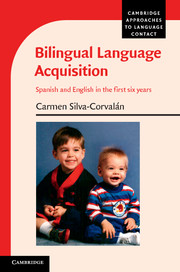Book contents
- Frontmatter
- Dedication
- Contents
- List of figures
- List of tables
- Series editor’s foreword
- Preface
- Acknowledgments
- List of abbreviations
- 1 Introduction
- 2 Methodology
- 3 Bilingual development
- 4 Subjects in English and Spanish
- 5 The order of constituents: subject position in English and Spanish
- 6 The acquisition of ser, estar, and be
- 7 The development of verb morphology
- 8 Discussion and conclusions
- Appendix 1 Transcription instructions
- Appendix 2 Calculation of MLUw
- Appendix 3 Spanish adjectives used with copulas up to age 6;0
- Appendix 4 The siblings’ early verb lexicon in English and Spanish
- Appendix 5 Excerpt from an adapted Goldilocks story
- References
- Index of authors
- General index
7 - The development of verb morphology
learning how to mark tense, aspect, and mood
Published online by Cambridge University Press: 18 December 2014
- Frontmatter
- Dedication
- Contents
- List of figures
- List of tables
- Series editor’s foreword
- Preface
- Acknowledgments
- List of abbreviations
- 1 Introduction
- 2 Methodology
- 3 Bilingual development
- 4 Subjects in English and Spanish
- 5 The order of constituents: subject position in English and Spanish
- 6 The acquisition of ser, estar, and be
- 7 The development of verb morphology
- 8 Discussion and conclusions
- Appendix 1 Transcription instructions
- Appendix 2 Calculation of MLUw
- Appendix 3 Spanish adjectives used with copulas up to age 6;0
- Appendix 4 The siblings’ early verb lexicon in English and Spanish
- Appendix 5 Excerpt from an adapted Goldilocks story
- References
- Index of authors
- General index
Summary
Introduction
Previous research (e.g., Lipski 1993; Montrul 2009; Silva-Corvalán 1994; Zentella 1997) has shown that in situations of societal bilingualism a functionally restricted language evidences grammatical simplification, among other phenomena. The question that arises is whether this stage of grammatical simplification is due to imperfect or incomplete acquisition in the early years of a bilingual’s life, or is a result of processes of attrition or loss of acquired knowledge of the underused language (Cuza 2010; Montrul 2002, 2005). I explore this question in this chapter, in addition to the issue that underlies the various chapters of the book, namely, the effect that differing levels of proficiency have on bilingual development.
The empirical study is conducted on data from the two developing bilingual siblings (Nico and Brennan), from the very first production of what in adult language would be considered to be “a verb” until age 5;11, when the siblings began to attend kindergarten in the Spanish-immersion track of a dual-language school (see Chapter 2). In this case, the central question of what effect reduced exposure to a language may have is explored in the development of tense, mood, and aspect markers (TMA) in English and Spanish. To this end, the chapter presents a description of the path of development of verb inflections in the two languages. It also gives information about the siblings’ verb lexicon in the early age stages. Although the study is centered on the siblings’ productive abilities, it is assumed that their comprehension abilities are at least equally developed. There is no evidence of misunderstandings in the early stages, but some instances of misunderstood conditionals in Spanish are attested in the later years, when communication includes reference to hypothetical situations and the language addressed to the children is more complex linguistically and in terms of content.
- Type
- Chapter
- Information
- Bilingual Language AcquisitionSpanish and English in the First Six Years, pp. 265 - 347Publisher: Cambridge University PressPrint publication year: 2014



